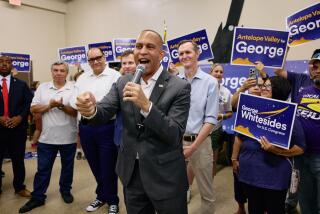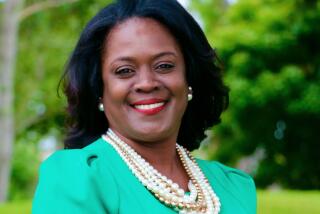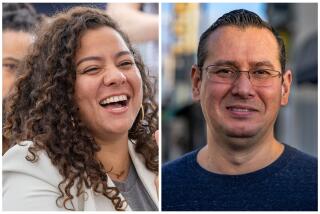Berman and Sherman tout their focus on local issues
Rep. Howard Berman crouched on a Sherman Oaks baseball field on a recent Saturday, striking a pose with two 4-year-old boys who had not yet had a chance to break in their uniforms.
A few miles away, Rep. Brad Sherman clutched a boxed American flag that had flown over the nation’s Capitol, to give to the players and parents gathered in Woodland Hills for the start of Little League season.
The opening-day ceremonies were a far cry from the weighty matters that typically occupy the veteran Democratic congressmen: Iran’s nuclear program, the staggering national debt, anxiety about the economy. But as the statesmen and onetime allies fight for the same San Fernando Valley seat — and perhaps for their political lives — they overlook few opportunities to live the adage that all politics is local.
Their particular challenge in this nationally watched contest is to distinguish themselves from one another. Both men have spent much of their adult lives in elected office, have millions in their campaign treasuries and hold similar views on many national and world issues. In Washington, they voted alike in support of the 2010 healthcare overhaul, the revamp of financial regulations the same year and the 2009 economic stimulus.
Back home, they’re working feverishly to one-up one another as the best man to ease freeway congestion, fight helicopter noise in residential neighborhoods and bring in money for transportation and recreation.
The gregarious Sherman, 57, has made it a point to keep a high district profile ever since his 1996 election to Congress. Now Berman, after decades of cruising to reelection since joining the House of Representatives in 1983, has been forced into the trenches with him.
In the months since California’s newly drawn political maps put the pair’s homes into the same district, the professorial Berman, 71, has co-hosted a fraud prevention workshop for seniors, visited an Encino elementary school whose students sent greetings to troops in Afghanistan and sat for an interview with a fifth-grader for a school project that was reproduced and circulated by the candidate’s campaign.
Sherman, who likes to note that he has hosted more than 160 local town hall meetings in 15 years on the job, recently notched appearances at a free foreclosure-prevention seminar, a temple’s 50th anniversary celebration and an Indian American festival. Sherman, a former tax lawyer and certified public accountant, also helped constituents with their income taxes after a news conference to announce the names of residents who were owed back refunds.
In this kind of old-fashioned “retail” politicking, little things can matter a lot, especially in a race between like-minded candidates. No detail is too small. For the pair’s first debate, Berman’s daughter and two grandchildren baked chocolate chip cookies to give to the audience. Sherman’s people, spotting the goodies, raced to a bakery to match the offerings.
There weren’t enough chairs for the large crowd, but as one attendee quipped, “We didn’t go hungry.”
When they’re not mixing with voters, the congressmen war in press releases and political ads over who delivers more for constituents.
“The race will be decided by people who drive the 405 Freeway and are concerned about police patrols,” Sherman said in a recent interview. “And to the extent it’s decided on who’s accessible and available to provide constituent service,” Sherman added, “the race is already over.”
Sherman cites $700 million he won for national parks, including the Santa Monica Mountains National Recreation Area, money to help widen the 5 Freeway and recreation funds for the Sepulveda Basin. Berman touts his successes in persuading Kaiser Permanente to keep its medical facilities — with its many jobs — open after the 1994 Northridge earthquake; turning the Hansen Dam recreation area from gang-infested to family-friendly; and pushing through tax breaks for the entertainment industry, another big local employer.
The key, Berman said, is effectiveness more than visibility. “I have a lot of things to say about what I’ve been able to do here on local issues…that distinguish me from my opponent,” Berman said. “It isn’t as much ideological as it is about just performance.”
A main bone of contention has been the massive widening project on the 405 Freeway, a traffic-choked artery in and out of the Valley. Each man wants credit for it. Sherman said he played a key role in funding the project. Berman fought back with copious news clips and officials’ testimonials showing his leadership on the issue.
They have also dueled over how many more police officers patrol the Valley as a result of a federal funding program in the 1990s, before Sherman went to Washington. Most Democrats, including Berman, supported it.
The senior lawmaker’s campaign claimed credit for thousands more cops on the street, then scaled the number back to 750 countywide in the face of contrary evidence provided by Sherman.
Neither flap mattered much to Mary A. Garcia, a longtime North Hollywood resident. She attended one of the candidates’ several debates, wanting “a close-up, personal view” of the two, hoping it would help her decide between them.
Garcia, 70, the executive director of the NoHo Regional Arts Council, said last week that she still hadn’t made up her mind. But she gave both contestants high marks for the meet-and-greets.
“It’s their opportunity to share with us who they are and what they’ve brought to the table and will bring,” Garcia said. Besides, she added, they owe their presence to voters.
“They need to see whom they are representing,” she said, “face to face.”
Merl reported from Los Angeles, Simon from Washington.
More to Read
Sign up for Essential California
The most important California stories and recommendations in your inbox every morning.
You may occasionally receive promotional content from the Los Angeles Times.












